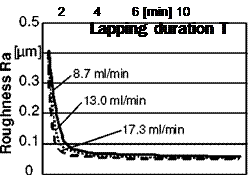The aim of coplanar lapping is to achieve high flatness in combination with a consistent surface quality for all workpieces. Also, the percent contact area is increased by levelling the roughness peaks. On account of these properties, lapping is often used in the finishing of ceramic sealing rings. In the following, we will introduce the coplanar processing of silicon-infiltrated silicon carbide (SiSiC).
Fig. 8-12 shows the path of surface roughness over lapping duration. The initial state was a pre-lapped SiSiC sample with a surface structure typical for lapping. It is clear that the roughness converges towards a value of Ra = 0.05 pm. Influences on the lapping disc can be ignored in the process.
A further important influencing variable is the concentration of abrasive particles in the active gap. This directly affects the active normal force per grain, which in turn influences the material removal rate achievable per grain. Higher concentrations result in the reduction of the individual grain forces and thus also of the material removal rate per grain. However, since more grains are engaged, the overall result is an increase in the removal rate. From a certain concentration onwards, saturation sets in (0.15 percent by weight), from which point no further increase of the material removal rate is possible.
Smaller concentrations and the lower removal rates associated with them have the further result that the asymptotic path of the roughness curves is clearly bottomed out. The minimum is reached at a much later point in time (Fig. 8-13). The saturation limit existing for the material removal speed, i. e. 0.15 percent by weight, is also reflected in the roughness curve. An increase in concentration does not change the roughness curve.
|
Volume flow: |
13 ml/min |
Plate material: |
E-Cu |
|
Grain material: |
diamond |
Lapping pressure: |
12 N/cm2 |
|
Grain size: |
2 — 4 pm |
Carrier fluid: |
H2O + Glycerin |
|
0.5 |
0.5 |
||||||
|
[pm/ |
[pm] ro 0.3 (Л (Л 0.2 0.1 о 0 |
||||||
|
Removal rate о p p p 1 to CO d, |
CD — °.10 %Gew |
||||||
|
CD = 0.15 %Gew |
|||||||
|
Cd — 0.20 %Gew |
|||||||
 |
 |
Concentration [%weight] Lapping duration T
|
Fig. 8-13. Progression of material removal rates and roughness curves given different concentrations
|
Fig. 8-14. The influence of the volume flow Vs on removal rates and surface qualities
The lapping slurry is held on the webs of the discs through surface tensions and in the grooves through capillary forces. This slurry volume present on the lapping disc remains constant. An increase in the volume flow is thus beneficial for the exchange of a used slurry, which can increase the removal rate (Fig. 8-14). The course of roughness values, however, remains nearly constant. Although the de
cline of the asymptotes is steeper given higher volume flows, the difference is not as significant as when the concentration is increased.
In addition to these influencing factors, the reproducibility of the results and the long-term stability of the lapping system, for example, also play essential roles.
